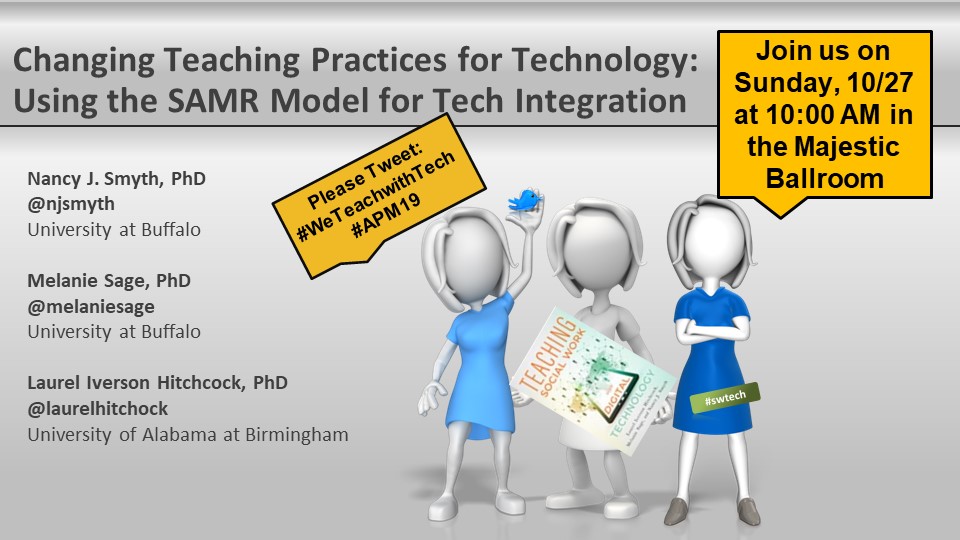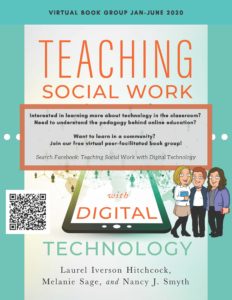#APM19 – Changing Teaching Practices for Technology: Using the SAMR Model for Technology Integration

On October 27, 2019 at 10:00 AM, during the Annual Program Meeting for the Council on Social Work Education in Denver CO, Melanie Sage and I will be sharing some insights from Chapter 4 of our book, Teaching Social Work with Digital Technology, co-written with Nancy Smyth. If you are still in Denver, please come find us in the Majestic Ballroom –Tower Building of the conference hotel. We will be sharing how Puentedura’s SAMR Model for Technology Integration can be used to incorporate technology into traditional social justice assignments in social work education. There will also be time to adopt one of your current assignments using the SMAR Model.

Additionally, we’ll be talking about our virtual book group that will be launch in January 2020. You can read more about it here:
For those of you who cannot make the presentation, we are including the details in this blog post.
For the presentation you can access the slides here:
We will be sharing one handout, which you can download here:
Finally, here is our conference proposal:
Abstract: Teaching with technology is a key skill for future social work educators. All social work educators, especially those early in their careers, find themselves teaching from syllabi they had no role in developing. Although there are many benefits to the “hand-me-down” syllabus, one of the limitations is that assignments are rarely updated to reflect the realities of the 21st century workplace, which now includes the use of technology to achieve practice outcomes for clients and organizations. The purpose of this workshop is show how to incorporate the use of technology into social work assignments across the curriculum.
We will introduce the workshop participants to Ruben Puentedura’s (2013a; 2013b) SAMR Model for Technology Integration, which provides a guide to adapting assignments and learning activities for technology-mediated use, regardless of the curricular content. The model identifies hierarchical levels of technology adaptation that range from using technology to enhance an assignment at the lowest end of the spectrum to incorporating technology in such a way that the learning activity is transformed into something new at the highest end. While an assignment can be adapted at any level of the model, some tech-enhanced modifications serve only replace one traditional tool, like a class role play, for another tool, such as a YouTube video of a role play. Other modifications change the assignment entirely and push students toward higher levels of thinking needed for digital literacy. The SAMR model can help social work educators reflect and evaluate how they are incorporating technology into a seated, hybrid or online classroom, across a range of assignments and activities.
There are two ways that the SAMR Model can help a social work educator enhance or transform an assignment with technology. First, the model promotes the development of digital literacy through the transformation of assignments and learning activities. Belshaw (2014) suggests that true digital literacy comes when an individual can effectively use digital tools, while also understanding the content and context associated with those tools. Second, the SAMR model supports the gradual inclusion of technology into a class assignment over time, giving the educator the opportunity to pilot test new technology tools and to experiment with an assignment from semester to semester. By taking measured steps in transforming an assignment, educators can improve their own technology skills without overwhelming students with complex assignments beyond their skill levels.
In this workshop, we will provide a brief overview of teaching with technology before focusing on how to infuse technology into an assignment, providing examples for social justice focused assignments. Participants will learn to identify ways to substitute, augment, modify or redefine existing learning strategies and assignments with technology-mediated learning strategies and assignments. By the end of the workshop, participants will have ideas and possible assignments that use technology to meet the learning needs identified in their syllabus.
References:
- Belshaw, D. (2014). The Essential Elements of Digital Literacies. Retrieved from: http://digitalliteraci.es/
- Puentedura, R. (2013a). SAMR: A contextualized introduction. Retrieved from: http://hippasus.com/rrpweblog/archives/2014/01/15/SAMRABriefContextualizedIntroduction.pdf
- Puentedura, R. (2013b). The SAMR Ladder: Questions and Transitions. Retrieved from http://www.hippasus.com/rrpweblog/archives/2013/10/26/SAMRLadder_Questions.pdf
- Puentedura, R. (2014). SAMR and Bloom’s Taxonomy: Assembling the Puzzle. Retrieved from: https://www.graphite.org/blog/samr-and-blooms-taxonomy-assembling-the-puzzle
How to cite this blog post:
Hitchcock, L.I., Sage, M. & Smyth, N.J. (2019, October 22). #APM19 – Changing Teaching Practices for Technology: Using the SAMR Model for Technology Integration [Blog Post]. Retrieved from: https://laureliversonhitchcock.org/2019/10/22/apm19-changing-teaching-practices-for-technology-using-the-samr-model-for-technology-integration/


